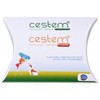Dosage and administration
The recommended dose rates are: 15 mg/kg bodyweight febantel, 5 mg/kg pyrantel (as embonate) and 5 mg/kg praziquantel. This is equivalent to 1 tablet of Cestem® Flavoured for medium and small dogs per 10 kg bodyweight or 1 tablet of Cestem® Flavoured for large dogs per 18-35kg, in one administration.
Dosages are as follows:
3-5 kg = ½ Cestem® Flavoured tablet for medium and small dogs
>5-10 kg = 1 Cestem® Flavoured tablet for medium and small dogs
>10-15 kg = 1½ Cestem® Flavoured tablet for medium and small dogs
>15-20 kg = 2 Cestem® Flavoured tablet for medium and small dogs
17.5 kg = ½ Cestem® Flavoured tablet for large dogs
>17.5-35 kg = 1 Cestem® Flavoured tablet for large dogs
>35-52.5 kg = 1½ Cestem® Flavoured tablet for large dogs
>52.5-70 kg = 2 Cestem® Flavoured tablet for large dogs
The smaller tablet size, Cestem® for medium and small dogs, should be used to achieve accurate dosing in dogs weighing less than 17.5 kg.
For oral administration, the tablets can be given to the dog with or without food. No starvation is needed before or after treatment. To ensure administration of a correct dose, body weight should be determined as accurately as possible. The dosing program should be established by the veterinary surgeon.
Puppies should be treated at 2 weeks of age and every 2 weeks until 12 weeks of age. Thereafter they should be treated at 3 month intervals. It is advisable to treat the bitch at the same time as the puppies.
For the control of Toxocara canis, nursing bitches should be dosed 2 weeks after giving birth and every two weeks until weaning.
For routine worm control adult dogs should be treated every 3 months. In case of confirmed single infestation by cestode or by nematode, a monovalent product containing a cestocide or a nematocide alone should be preferred.
For routine treatment a single dose is recommended.
In the event of heavy roundworm infestation a repeat dose should be given after 14 days.
If an infestation caused by Echinococcus (E. granulosus) is detected in dogs, a repetition of the treatment is recommended for safety purpose.
Contra-indications, warnings, etc
Do not use in animals with a known sensitivity to the active ingredients or to any of the excipients.
Parasite resistance to any particular class of anthelmintic may develop following frequent, repeated use of anthelmintic of that class.
Fleas serve as intermediate hosts for one common type of tapeworm – Dipylidium caninum. Tapeworm infestation may reoccur unless control of intermediate hosts such as fleas, mice etc is undertaken.
The product is not recommended for use in puppies of less than 3 kg bodyweight.
Use during pregnancy and lactation
Do not use in pregnant bitches during the first 4 weeks of pregnancy.
The product may be used during lactation.
Interaction
Do not use simultaneously with piperazine, as the anthelmintic effects of pyrantel and piperazine may be antagonized.
Plasma concentrations of praziquantel may be decreased by concomitant administration with drugs that increase the activity of cytochrome P-450 enzymes (e.g. dexamethasone, phenobarbital). Concurrent use with other cholinergic compounds can lead to toxicity.
Overdose
In safety studies, single doses of 5 times (4 times in very young puppies) the recommended dose or greater gave rise to occasional vomiting.
Special precautions to be taken by the person administering the medicinal product to animals
Wash hands after administration to the animal.
In case of accidental ingestion, seek medical advice immediately and show the package leaflet or the label to the physician.
People with known hypersensitivity to any of the ingredients should avoid contact with the veterinary medicinal product.
Any unused veterinary medicinal product or waste materials derived from such veterinary medicinal products should be disposed of in accordance with local requirements.
For animal treatment only. Keep out of reach of children.

